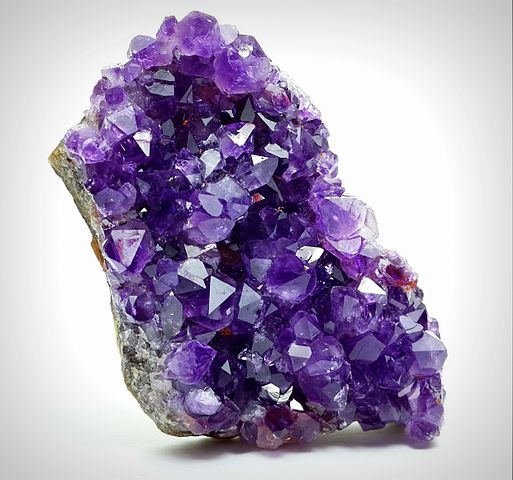Amethyst
Amethyst is a violet variety of quartz. The name comes from the Koine Greek αμέθυστος amethystos from α- ("not") and μεθύσκω methysko ("intoxicate"), a reference to the belief that the stone protected its owner from drunkenness. Ancient Greeks wore amethyst and carved drinking vessels from it in the belief that it would prevent intoxication.
Structure
Amethyst is a purple variety of quartz (SiO2) and owes its violet color to irradiation, impurities of iron (Fe3+) and in some cases other transition metals, and the presence of other trace elements, which result in complex crystal lattice substitutions. Amethyst can fade in tone if overexposed to light sources, and can be artificially darkened with adequate irradiation. It does not fluoresce under either short-wave or long-wave UV light.
Amethyst is a three-dimensional network of tetrahedra where the silicon atoms are in the center and are surrounded by four oxygen atoms located at the vertices of a tetrahedron. This structure is quite rigid and results in quartz's hardness and resistance to weathering. The hardness of the mineral is the same as quartz, thus making it suitable for use in jewelry.
The highest-grade amethyst (called "Deep Russian") is exceptionally rare. When one is found, its value is dependent on the demand of collectors. The highest-grade sapphires or rubies are still orders of magnitude more expensive than amethyst.
Occurrence
Amethyst is found in many locations around the world. Between 2000 and 2010, the greatest production was from:
- Brazil: Marabá and Pau d'Arco, Pará; and the Paraná Basin, Rio Grande do Sul
- Bolivia: Sandoval, Santa Cruz
- Uruguay: Artigas
- Zambia: Kalomo
- Canada: Thunder Bay, Ontario
Lesser amounts are found in many other locations in Spain, Argentina, Russia, Afghanistan, South Korea, Mexico, and the United States.
A large geode, or "amethyst-grotto," from near Santa Cruz in southern Brazil was presented at a 1902 exhibition in Düsseldorf, Germany.
Usage
Amethyst was used as a gemstone by the ancient Egyptians and was largely employed in antiquity for intaglio engraved gems.
The ancient Greeks believed amethyst gems could prevent intoxication, while medieval European soldiers wore amethyst amulets as protection in battle in the belief that amethysts heal people and keep them cool-headed. In the Middle Ages, it was considered a symbol of royalty and used to decorate English regalia. Beads of amethyst were found in Anglo-Saxon graves in England.
In the Old World, amethyst was considered one of the cardinal gems, in that it was one of the five gemstones considered precious above all others, until large deposits were found in Brazil.
Spiritual meanings
The meaning of amethyst varies from time to time and culture, which is why amethyst has different meanings in Feng Shui and focuses on increasing wealth. In ancient China, it was also used as a powerful tool to remove negative energies and drive away the hazards of daily life. Tibetans consider amethyst sacred to the Buddha and make prayer beads from it.
Anglican bishops wear an episcopal ring often set with an amethyst, an allusion to the description of the Apostles as "not drunk" at Pentecost in Acts 2:15.
Astrology
Amethyst has many astrological associations. It is connected to Barbiel, the angel who rules over the sign of Scorpio and is the birthstone of February.
In the zodiac, amethyst is associated with the signs Virgo, Sagittarius, Capricorn, Aquarius, and Pisces.
It is the stone of the planet Jupiter.
